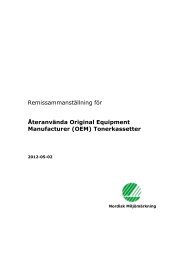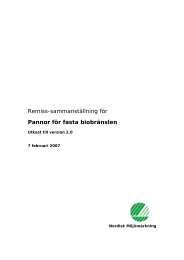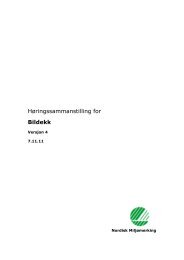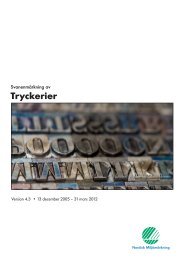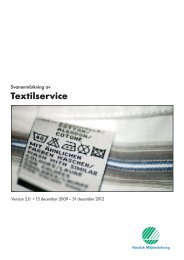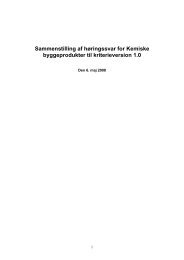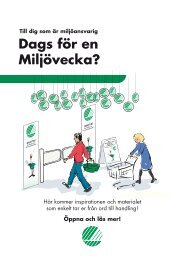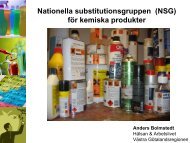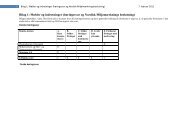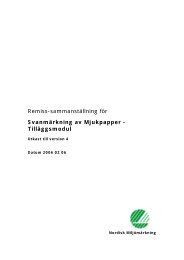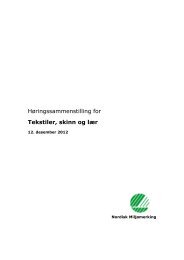Småhus, flerbostadshus och förskolebyggnader - Svanen
Småhus, flerbostadshus och förskolebyggnader - Svanen
Småhus, flerbostadshus och förskolebyggnader - Svanen
You also want an ePaper? Increase the reach of your titles
YUMPU automatically turns print PDFs into web optimized ePapers that Google loves.
Nordisk Miljømerking<br />
Hus, leiligheter og barnehager 089/versjon 2<br />
Høringssammenstilling, oppdatert 10. august 2010<br />
environmental indicators were developed against which all construction products need to<br />
be assessed. These indicators are agreed by industry, consumers, environmental groups<br />
and regulators and cover all aspects related to the environmental performance of the<br />
product. The most prominent activity currently underway is the standardisation work<br />
undertaken by CEN/TC350 and mandated by the European Commission. The standards<br />
will also include the measurement methods developed by CEN/TC 351 on the release of<br />
dangerous substances to the indoor air and to soil and ground water. RT believes that the<br />
standards of TC 350 and 351 provide the most appropriate framework for the Nordic<br />
Ecolabel, as they provide a holistic view and allow the assessment of products at the<br />
building level.<br />
A building is not a simple product but a complex assembly of hundreds of different<br />
products, materials and systems, which interact amongst each other and with the indoor<br />
and outdoor environment. Experts across Europe agree that the environmental<br />
performance of construction products can only be assessed at the building level in a given<br />
end‐use design, i.e. when the above mentioned interactions are known and can be<br />
examined. A recent study conducted by the EU Joint Research Centre shows that the use<br />
phase accounts for 98 % of the environmental impacts of buildings in the case of existing<br />
buildings and about 80 % in the case of new buildings. In other words, material‐related<br />
indicators must focus on the environmental performance of products in a given end‐use<br />
application over their life cycle.<br />
The European polymer producers (PlasticsEurope), together with the European<br />
PVC resin producers (ECVM), and the European plastics converting industry<br />
(EuPC)<br />
General comments on restrictions on the materials and chemicals used in<br />
construction<br />
The plastics industries fully support … a major contribution to achieving overriding goals<br />
such as climate protection. For buildings, life-cycle environmental impacts are largely<br />
associated with the use phase, and therefore particular emphasis should be placed on usephase<br />
performance.<br />
The current Nordic Swan draft does indeed propose numerous use-phase criteria, but at<br />
the same time is proposing restrictions on the materials and chemicals used in<br />
construction. Where no risk is associated with the use of these materials and chemicals,<br />
no benefit can be attained by restrictions. On the contrary, the proposed restrictions could<br />
lead to technical barriers in achieving the use-phase performance goals and ultimately<br />
promote less sustainable construction material and buildings, which would undermine the<br />
credibility of the Type I ecolabels in general, and the Nordic Swan in particular.<br />
The authors should be aware of the great newly developed energy saving materials and<br />
equipment and the document, as it stands now, will prevent these materials/equipments<br />
from being used, with a clear negative impact on the environment<br />
Although exceptions on the restrictions are highly needed, we notice that no such<br />
exceptions are foreseen !<br />
21 (165)



